Identifying Factors Affecting Customer Satisfaction at Workers Cafe
VerifiedAdded on 2019/12/04
|47
|10605
|163
Report
AI Summary
This research project investigates the factors affecting customer satisfaction at Workers Cafe, a coffee shop located in London. The report begins with an introduction outlining the research background, aims, and objectives, followed by a review of secondary data on the UK coffee shop industry and factors influencing customer satisfaction. The methodology section details the research approach, philosophy, design, data collection methods (including primary data through questionnaires), sampling, and data analysis techniques. The analysis and findings chapter presents the collected data in the form of graphs and interpretations. The report concludes with key findings, recommendations, and a review of the methodology. The study aims to evaluate functional and emotional benefits provided by Workers Cafe, assess customer satisfaction with products and services, and find opinions about price and food quality. The research also includes an implementation plan and personal reflections.

RESEARCH PROJECT:
TO IDENTIFY THE FACTORS WHICH
AFFECTS THE CUSTOMER SATISFACTION AT
WORKERS COFFEE
TO IDENTIFY THE FACTORS WHICH
AFFECTS THE CUSTOMER SATISFACTION AT
WORKERS COFFEE
Paraphrase This Document
Need a fresh take? Get an instant paraphrase of this document with our AI Paraphraser
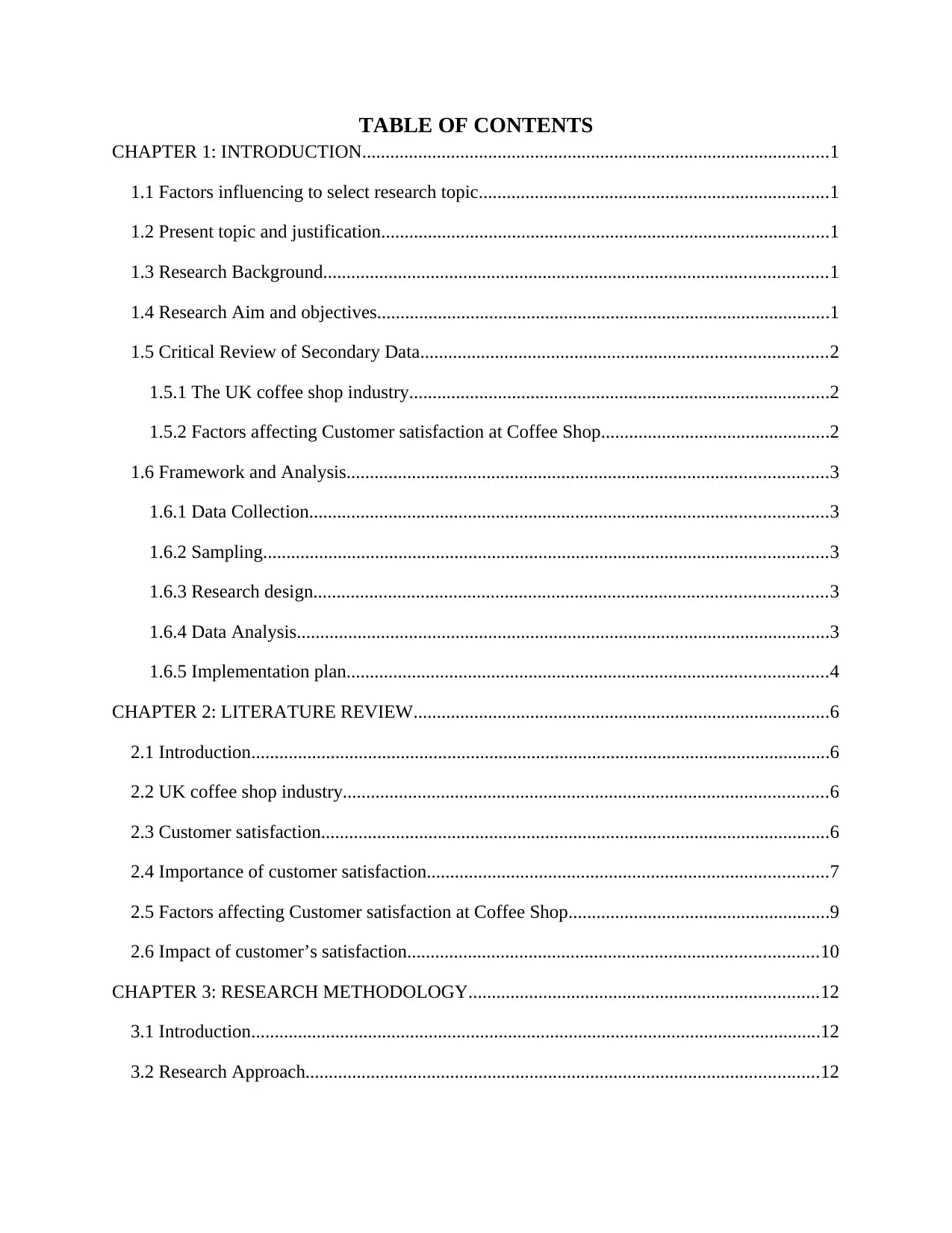
TABLE OF CONTENTS
CHAPTER 1: INTRODUCTION....................................................................................................1
1.1 Factors influencing to select research topic...........................................................................1
1.2 Present topic and justification................................................................................................1
1.3 Research Background............................................................................................................1
1.4 Research Aim and objectives.................................................................................................1
1.5 Critical Review of Secondary Data.......................................................................................2
1.5.1 The UK coffee shop industry..........................................................................................2
1.5.2 Factors affecting Customer satisfaction at Coffee Shop.................................................2
1.6 Framework and Analysis.......................................................................................................3
1.6.1 Data Collection...............................................................................................................3
1.6.2 Sampling.........................................................................................................................3
1.6.3 Research design..............................................................................................................3
1.6.4 Data Analysis..................................................................................................................3
1.6.5 Implementation plan.......................................................................................................4
CHAPTER 2: LITERATURE REVIEW.........................................................................................6
2.1 Introduction............................................................................................................................6
2.2 UK coffee shop industry........................................................................................................6
2.3 Customer satisfaction.............................................................................................................6
2.4 Importance of customer satisfaction......................................................................................7
2.5 Factors affecting Customer satisfaction at Coffee Shop........................................................9
2.6 Impact of customer’s satisfaction........................................................................................10
CHAPTER 3: RESEARCH METHODOLOGY...........................................................................12
3.1 Introduction..........................................................................................................................12
3.2 Research Approach..............................................................................................................12
CHAPTER 1: INTRODUCTION....................................................................................................1
1.1 Factors influencing to select research topic...........................................................................1
1.2 Present topic and justification................................................................................................1
1.3 Research Background............................................................................................................1
1.4 Research Aim and objectives.................................................................................................1
1.5 Critical Review of Secondary Data.......................................................................................2
1.5.1 The UK coffee shop industry..........................................................................................2
1.5.2 Factors affecting Customer satisfaction at Coffee Shop.................................................2
1.6 Framework and Analysis.......................................................................................................3
1.6.1 Data Collection...............................................................................................................3
1.6.2 Sampling.........................................................................................................................3
1.6.3 Research design..............................................................................................................3
1.6.4 Data Analysis..................................................................................................................3
1.6.5 Implementation plan.......................................................................................................4
CHAPTER 2: LITERATURE REVIEW.........................................................................................6
2.1 Introduction............................................................................................................................6
2.2 UK coffee shop industry........................................................................................................6
2.3 Customer satisfaction.............................................................................................................6
2.4 Importance of customer satisfaction......................................................................................7
2.5 Factors affecting Customer satisfaction at Coffee Shop........................................................9
2.6 Impact of customer’s satisfaction........................................................................................10
CHAPTER 3: RESEARCH METHODOLOGY...........................................................................12
3.1 Introduction..........................................................................................................................12
3.2 Research Approach..............................................................................................................12
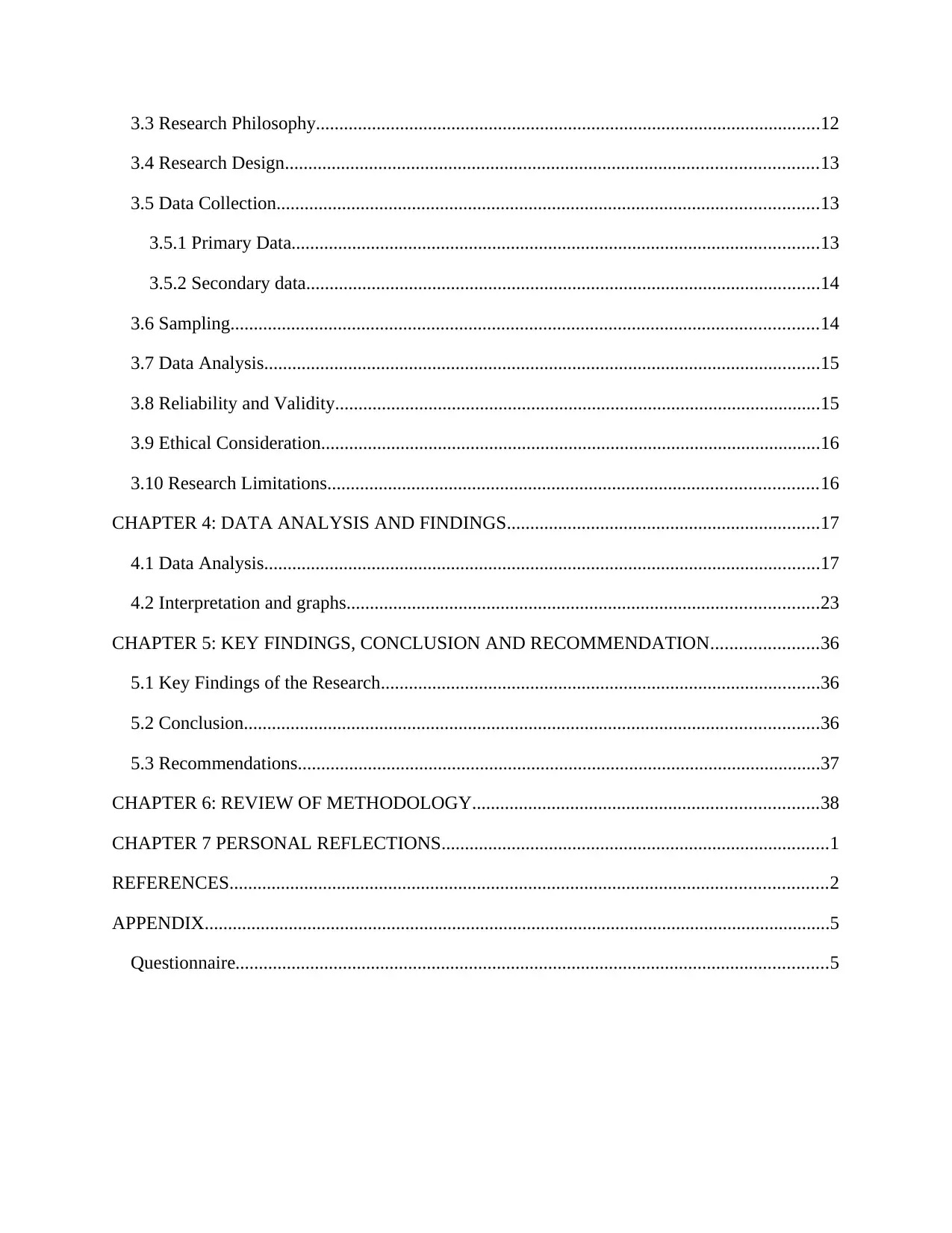
3.3 Research Philosophy............................................................................................................12
3.4 Research Design..................................................................................................................13
3.5 Data Collection....................................................................................................................13
3.5.1 Primary Data.................................................................................................................13
3.5.2 Secondary data..............................................................................................................14
3.6 Sampling..............................................................................................................................14
3.7 Data Analysis.......................................................................................................................15
3.8 Reliability and Validity........................................................................................................15
3.9 Ethical Consideration...........................................................................................................16
3.10 Research Limitations.........................................................................................................16
CHAPTER 4: DATA ANALYSIS AND FINDINGS...................................................................17
4.1 Data Analysis.......................................................................................................................17
4.2 Interpretation and graphs.....................................................................................................23
CHAPTER 5: KEY FINDINGS, CONCLUSION AND RECOMMENDATION.......................36
5.1 Key Findings of the Research..............................................................................................36
5.2 Conclusion...........................................................................................................................36
5.3 Recommendations................................................................................................................37
CHAPTER 6: REVIEW OF METHODOLOGY..........................................................................38
CHAPTER 7 PERSONAL REFLECTIONS...................................................................................1
REFERENCES................................................................................................................................2
APPENDIX......................................................................................................................................5
Questionnaire...............................................................................................................................5
3.4 Research Design..................................................................................................................13
3.5 Data Collection....................................................................................................................13
3.5.1 Primary Data.................................................................................................................13
3.5.2 Secondary data..............................................................................................................14
3.6 Sampling..............................................................................................................................14
3.7 Data Analysis.......................................................................................................................15
3.8 Reliability and Validity........................................................................................................15
3.9 Ethical Consideration...........................................................................................................16
3.10 Research Limitations.........................................................................................................16
CHAPTER 4: DATA ANALYSIS AND FINDINGS...................................................................17
4.1 Data Analysis.......................................................................................................................17
4.2 Interpretation and graphs.....................................................................................................23
CHAPTER 5: KEY FINDINGS, CONCLUSION AND RECOMMENDATION.......................36
5.1 Key Findings of the Research..............................................................................................36
5.2 Conclusion...........................................................................................................................36
5.3 Recommendations................................................................................................................37
CHAPTER 6: REVIEW OF METHODOLOGY..........................................................................38
CHAPTER 7 PERSONAL REFLECTIONS...................................................................................1
REFERENCES................................................................................................................................2
APPENDIX......................................................................................................................................5
Questionnaire...............................................................................................................................5
⊘ This is a preview!⊘
Do you want full access?
Subscribe today to unlock all pages.

Trusted by 1+ million students worldwide

CHAPTER 1: INTRODUCTION
1.1 Factors influencing to select research topic
There are a multitude of factors that influenced me to choose this project topic. The main
factor that made me write about this specific topic is the fact that I worked in this type of
industry and I also plan to work in the future, because this is a huge one and gave you a lot of job
opportunities. The information I learned at my HND courses also motivated me in my selection
but as well my prior knowledge about this sector helped me in my decision. I think that choosing
a topic that comes from my area of interest could provide me more details about my future
research.
Another factor in my decision is time. Due to the fact that I know the place and the usual
costumers it will save some time in doing the research. Knowing this place I have a personal
curiosity, why people choose this sector instead of a well-known brand. This specific topic it
doesn’t require too many finance because it is about people choices and opinions.
1.2 Present topic and justification
Customer satisfaction is the most important thing for the business. Long term satisfaction
brings long term profitability and sales for the company. Satisfied customers open many gates of
business opportunities (Alam, Mohd and Hisham, 2011). This research report is about measuring
the level of customer satisfaction at a coffee shop named Workers Cafe. The UK coffee shop
industry has noticed good generation of revenue and outlet volume in the recent years.
1.3 Research Background
For the purpose of the study, Workers Cafe has been selected because it is the place I
used to work before. The café is a lovely café located on a High Street near the tube station in
North of London. It offers traditional English breakfast, lunch and dinner. This research report
examines which are the factors which affect the customer satisfaction while buying products at
Workers Cafe.
1.4 Research Aim and objectives
The major aim of the research is to identify the factors which affect the customer
satisfaction at Workers Cafe. Following objectives have been framed:
1
1.1 Factors influencing to select research topic
There are a multitude of factors that influenced me to choose this project topic. The main
factor that made me write about this specific topic is the fact that I worked in this type of
industry and I also plan to work in the future, because this is a huge one and gave you a lot of job
opportunities. The information I learned at my HND courses also motivated me in my selection
but as well my prior knowledge about this sector helped me in my decision. I think that choosing
a topic that comes from my area of interest could provide me more details about my future
research.
Another factor in my decision is time. Due to the fact that I know the place and the usual
costumers it will save some time in doing the research. Knowing this place I have a personal
curiosity, why people choose this sector instead of a well-known brand. This specific topic it
doesn’t require too many finance because it is about people choices and opinions.
1.2 Present topic and justification
Customer satisfaction is the most important thing for the business. Long term satisfaction
brings long term profitability and sales for the company. Satisfied customers open many gates of
business opportunities (Alam, Mohd and Hisham, 2011). This research report is about measuring
the level of customer satisfaction at a coffee shop named Workers Cafe. The UK coffee shop
industry has noticed good generation of revenue and outlet volume in the recent years.
1.3 Research Background
For the purpose of the study, Workers Cafe has been selected because it is the place I
used to work before. The café is a lovely café located on a High Street near the tube station in
North of London. It offers traditional English breakfast, lunch and dinner. This research report
examines which are the factors which affect the customer satisfaction while buying products at
Workers Cafe.
1.4 Research Aim and objectives
The major aim of the research is to identify the factors which affect the customer
satisfaction at Workers Cafe. Following objectives have been framed:
1
Paraphrase This Document
Need a fresh take? Get an instant paraphrase of this document with our AI Paraphraser
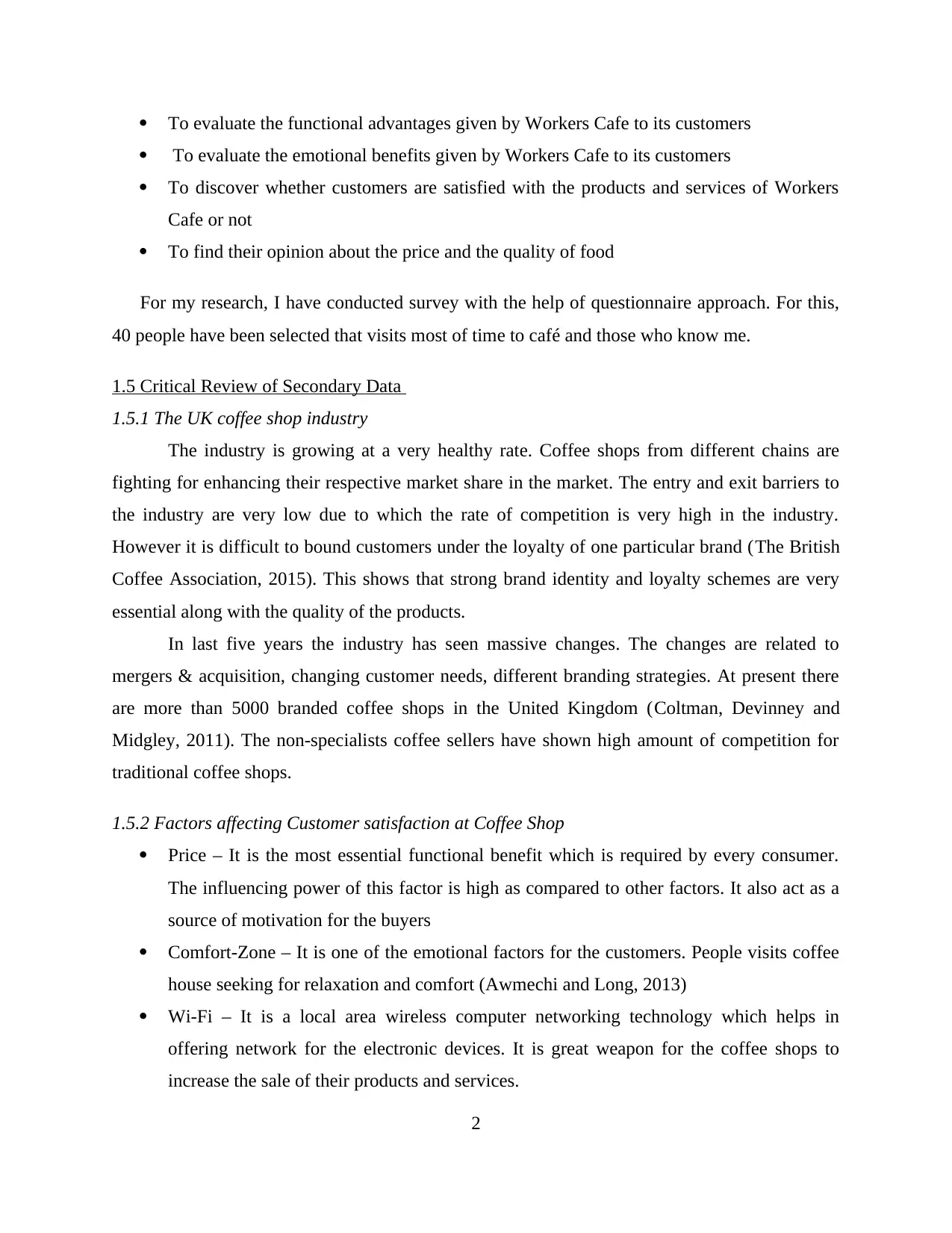
To evaluate the functional advantages given by Workers Cafe to its customers
To evaluate the emotional benefits given by Workers Cafe to its customers
To discover whether customers are satisfied with the products and services of Workers
Cafe or not
To find their opinion about the price and the quality of food
For my research, I have conducted survey with the help of questionnaire approach. For this,
40 people have been selected that visits most of time to café and those who know me.
1.5 Critical Review of Secondary Data
1.5.1 The UK coffee shop industry
The industry is growing at a very healthy rate. Coffee shops from different chains are
fighting for enhancing their respective market share in the market. The entry and exit barriers to
the industry are very low due to which the rate of competition is very high in the industry.
However it is difficult to bound customers under the loyalty of one particular brand (The British
Coffee Association, 2015). This shows that strong brand identity and loyalty schemes are very
essential along with the quality of the products.
In last five years the industry has seen massive changes. The changes are related to
mergers & acquisition, changing customer needs, different branding strategies. At present there
are more than 5000 branded coffee shops in the United Kingdom (Coltman, Devinney and
Midgley, 2011). The non-specialists coffee sellers have shown high amount of competition for
traditional coffee shops.
1.5.2 Factors affecting Customer satisfaction at Coffee Shop
Price – It is the most essential functional benefit which is required by every consumer.
The influencing power of this factor is high as compared to other factors. It also act as a
source of motivation for the buyers
Comfort-Zone – It is one of the emotional factors for the customers. People visits coffee
house seeking for relaxation and comfort (Awmechi and Long, 2013)
Wi-Fi – It is a local area wireless computer networking technology which helps in
offering network for the electronic devices. It is great weapon for the coffee shops to
increase the sale of their products and services.
2
To evaluate the emotional benefits given by Workers Cafe to its customers
To discover whether customers are satisfied with the products and services of Workers
Cafe or not
To find their opinion about the price and the quality of food
For my research, I have conducted survey with the help of questionnaire approach. For this,
40 people have been selected that visits most of time to café and those who know me.
1.5 Critical Review of Secondary Data
1.5.1 The UK coffee shop industry
The industry is growing at a very healthy rate. Coffee shops from different chains are
fighting for enhancing their respective market share in the market. The entry and exit barriers to
the industry are very low due to which the rate of competition is very high in the industry.
However it is difficult to bound customers under the loyalty of one particular brand (The British
Coffee Association, 2015). This shows that strong brand identity and loyalty schemes are very
essential along with the quality of the products.
In last five years the industry has seen massive changes. The changes are related to
mergers & acquisition, changing customer needs, different branding strategies. At present there
are more than 5000 branded coffee shops in the United Kingdom (Coltman, Devinney and
Midgley, 2011). The non-specialists coffee sellers have shown high amount of competition for
traditional coffee shops.
1.5.2 Factors affecting Customer satisfaction at Coffee Shop
Price – It is the most essential functional benefit which is required by every consumer.
The influencing power of this factor is high as compared to other factors. It also act as a
source of motivation for the buyers
Comfort-Zone – It is one of the emotional factors for the customers. People visits coffee
house seeking for relaxation and comfort (Awmechi and Long, 2013)
Wi-Fi – It is a local area wireless computer networking technology which helps in
offering network for the electronic devices. It is great weapon for the coffee shops to
increase the sale of their products and services.
2
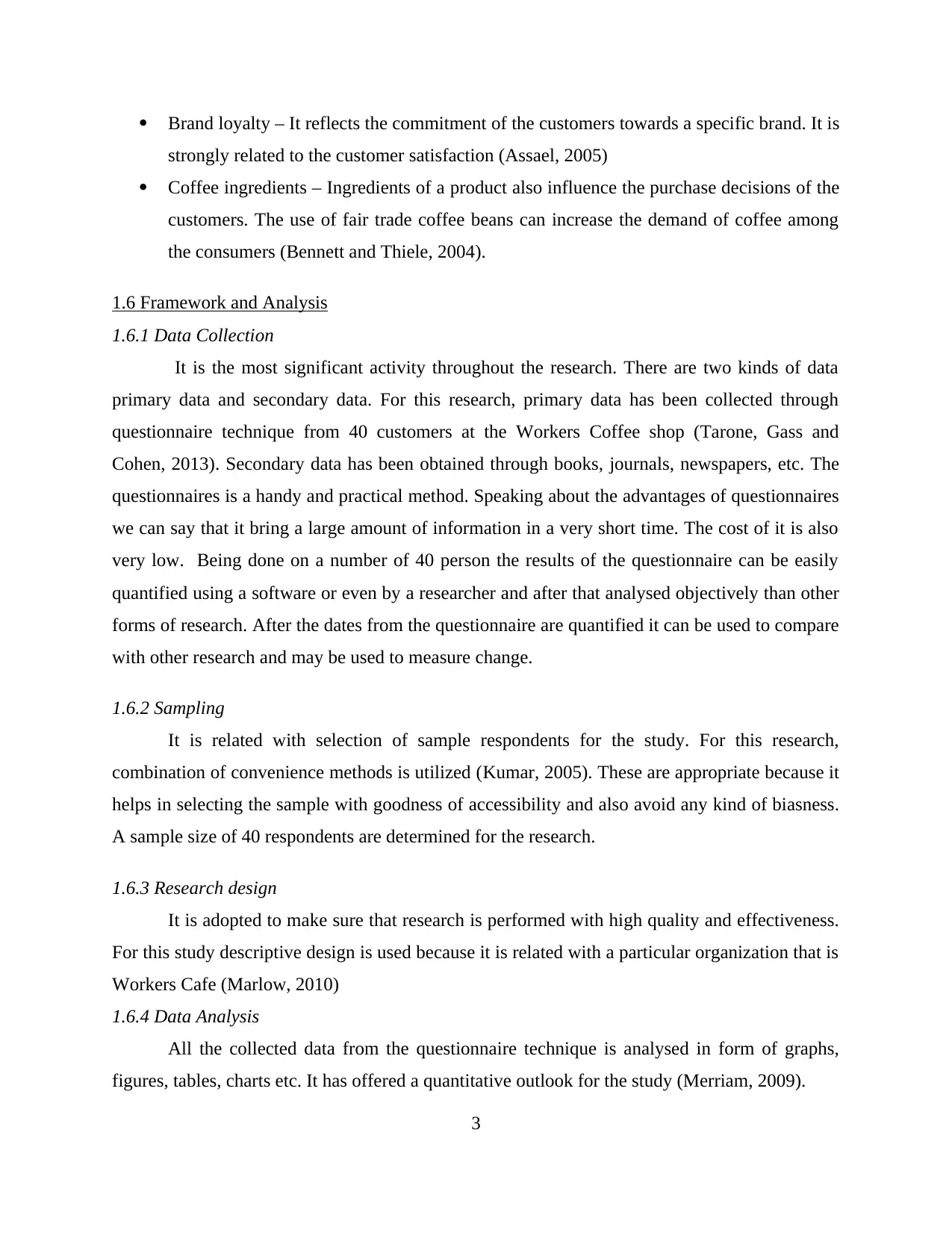
Brand loyalty – It reflects the commitment of the customers towards a specific brand. It is
strongly related to the customer satisfaction (Assael, 2005)
Coffee ingredients – Ingredients of a product also influence the purchase decisions of the
customers. The use of fair trade coffee beans can increase the demand of coffee among
the consumers (Bennett and Thiele, 2004).
1.6 Framework and Analysis
1.6.1 Data Collection
It is the most significant activity throughout the research. There are two kinds of data
primary data and secondary data. For this research, primary data has been collected through
questionnaire technique from 40 customers at the Workers Coffee shop (Tarone, Gass and
Cohen, 2013). Secondary data has been obtained through books, journals, newspapers, etc. The
questionnaires is a handy and practical method. Speaking about the advantages of questionnaires
we can say that it bring a large amount of information in a very short time. The cost of it is also
very low. Being done on a number of 40 person the results of the questionnaire can be easily
quantified using a software or even by a researcher and after that analysed objectively than other
forms of research. After the dates from the questionnaire are quantified it can be used to compare
with other research and may be used to measure change.
1.6.2 Sampling
It is related with selection of sample respondents for the study. For this research,
combination of convenience methods is utilized (Kumar, 2005). These are appropriate because it
helps in selecting the sample with goodness of accessibility and also avoid any kind of biasness.
A sample size of 40 respondents are determined for the research.
1.6.3 Research design
It is adopted to make sure that research is performed with high quality and effectiveness.
For this study descriptive design is used because it is related with a particular organization that is
Workers Cafe (Marlow, 2010)
1.6.4 Data Analysis
All the collected data from the questionnaire technique is analysed in form of graphs,
figures, tables, charts etc. It has offered a quantitative outlook for the study (Merriam, 2009).
3
strongly related to the customer satisfaction (Assael, 2005)
Coffee ingredients – Ingredients of a product also influence the purchase decisions of the
customers. The use of fair trade coffee beans can increase the demand of coffee among
the consumers (Bennett and Thiele, 2004).
1.6 Framework and Analysis
1.6.1 Data Collection
It is the most significant activity throughout the research. There are two kinds of data
primary data and secondary data. For this research, primary data has been collected through
questionnaire technique from 40 customers at the Workers Coffee shop (Tarone, Gass and
Cohen, 2013). Secondary data has been obtained through books, journals, newspapers, etc. The
questionnaires is a handy and practical method. Speaking about the advantages of questionnaires
we can say that it bring a large amount of information in a very short time. The cost of it is also
very low. Being done on a number of 40 person the results of the questionnaire can be easily
quantified using a software or even by a researcher and after that analysed objectively than other
forms of research. After the dates from the questionnaire are quantified it can be used to compare
with other research and may be used to measure change.
1.6.2 Sampling
It is related with selection of sample respondents for the study. For this research,
combination of convenience methods is utilized (Kumar, 2005). These are appropriate because it
helps in selecting the sample with goodness of accessibility and also avoid any kind of biasness.
A sample size of 40 respondents are determined for the research.
1.6.3 Research design
It is adopted to make sure that research is performed with high quality and effectiveness.
For this study descriptive design is used because it is related with a particular organization that is
Workers Cafe (Marlow, 2010)
1.6.4 Data Analysis
All the collected data from the questionnaire technique is analysed in form of graphs,
figures, tables, charts etc. It has offered a quantitative outlook for the study (Merriam, 2009).
3
⊘ This is a preview!⊘
Do you want full access?
Subscribe today to unlock all pages.

Trusted by 1+ million students worldwide
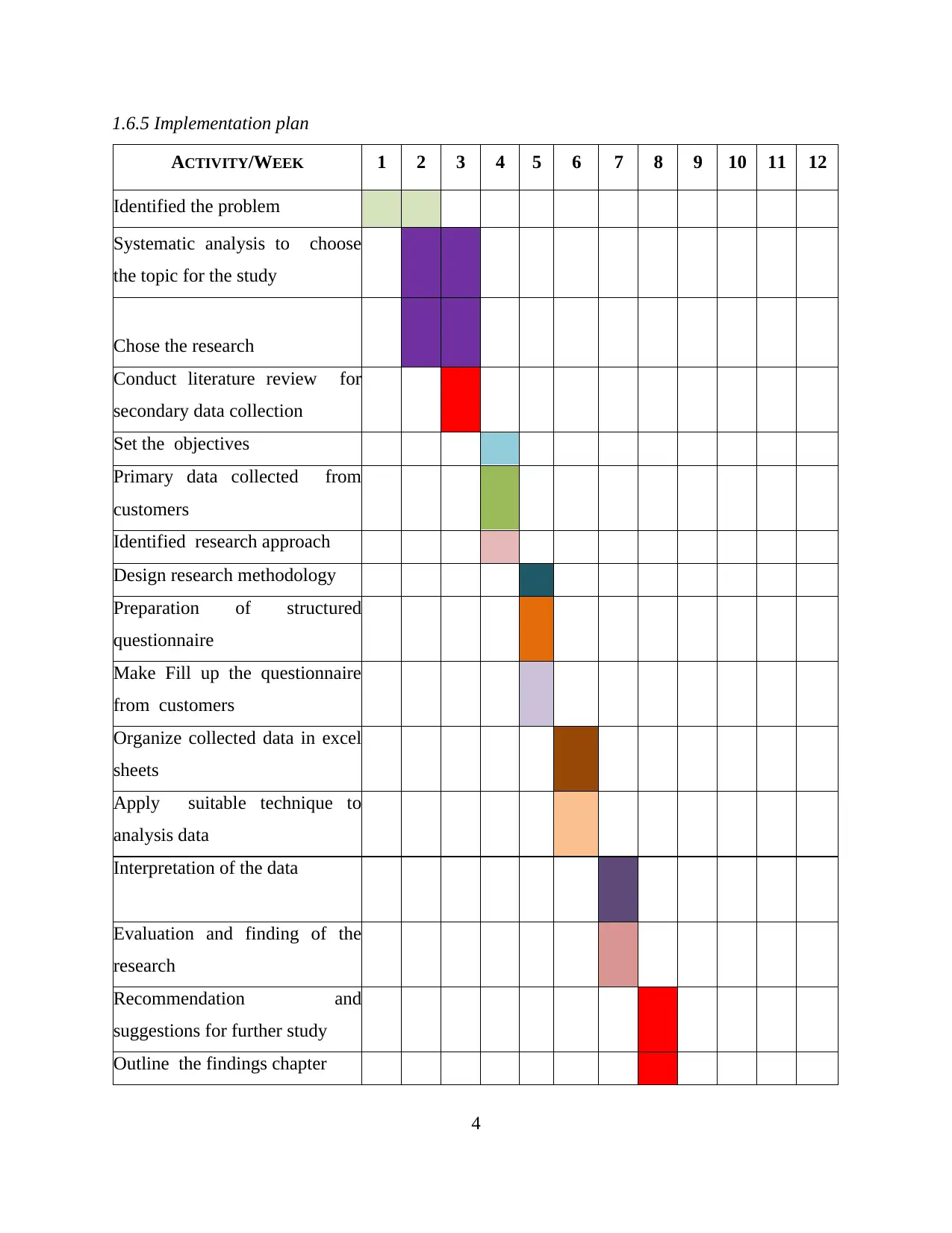
1.6.5 Implementation plan
ACTIVITY/WEEK 1 2 3 4 5 6 7 8 9 10 11 12
Identified the problem
Systematic analysis to choose
the topic for the study
Chose the research
Conduct literature review for
secondary data collection
Set the objectives
Primary data collected from
customers
Identified research approach
Design research methodology
Preparation of structured
questionnaire
Make Fill up the questionnaire
from customers
Organize collected data in excel
sheets
Apply suitable technique to
analysis data
Interpretation of the data
Evaluation and finding of the
research
Recommendation and
suggestions for further study
Outline the findings chapter
4
ACTIVITY/WEEK 1 2 3 4 5 6 7 8 9 10 11 12
Identified the problem
Systematic analysis to choose
the topic for the study
Chose the research
Conduct literature review for
secondary data collection
Set the objectives
Primary data collected from
customers
Identified research approach
Design research methodology
Preparation of structured
questionnaire
Make Fill up the questionnaire
from customers
Organize collected data in excel
sheets
Apply suitable technique to
analysis data
Interpretation of the data
Evaluation and finding of the
research
Recommendation and
suggestions for further study
Outline the findings chapter
4
Paraphrase This Document
Need a fresh take? Get an instant paraphrase of this document with our AI Paraphraser
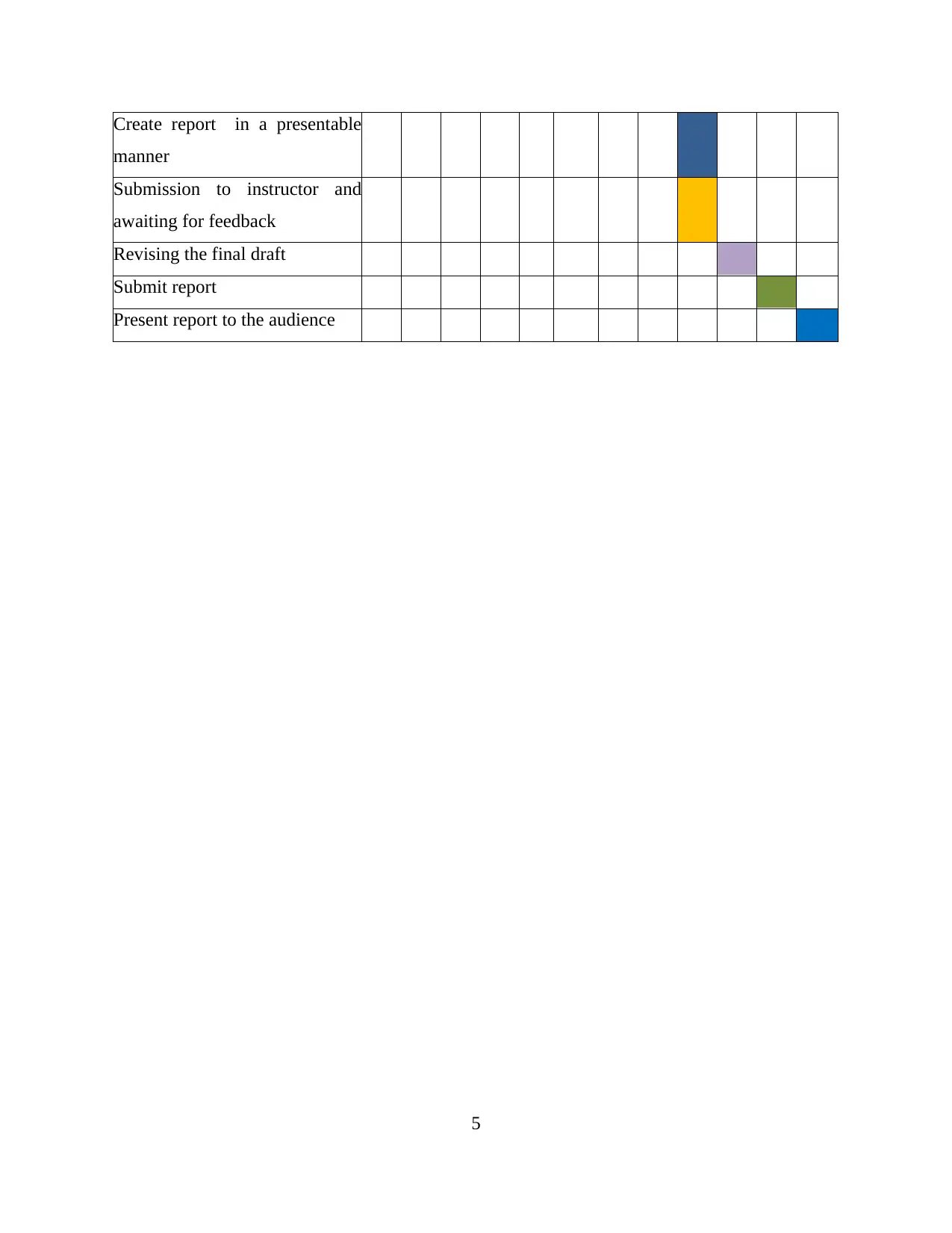
Create report in a presentable
manner
Submission to instructor and
awaiting for feedback
Revising the final draft
Submit report
Present report to the audience
5
manner
Submission to instructor and
awaiting for feedback
Revising the final draft
Submit report
Present report to the audience
5
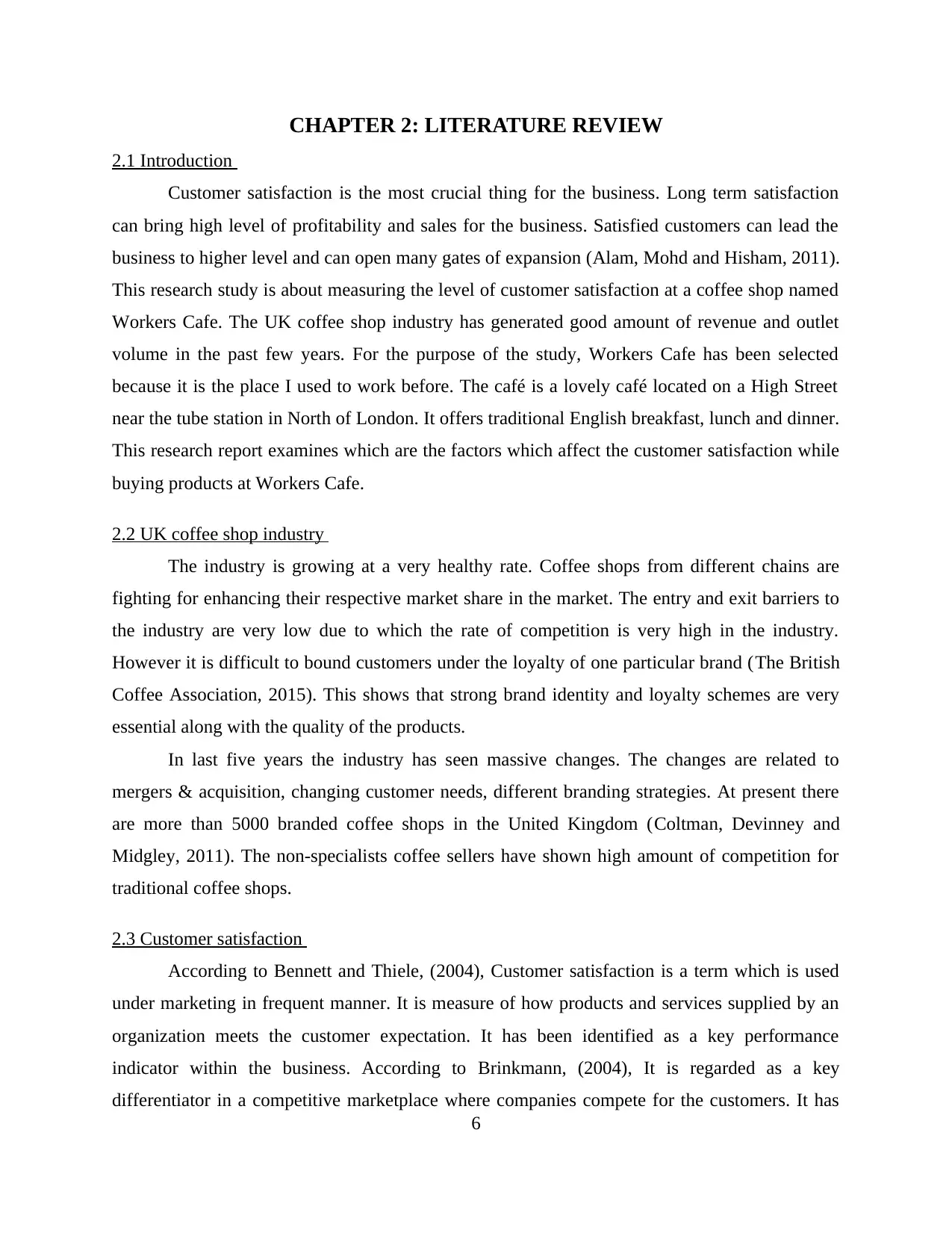
CHAPTER 2: LITERATURE REVIEW
2.1 Introduction
Customer satisfaction is the most crucial thing for the business. Long term satisfaction
can bring high level of profitability and sales for the business. Satisfied customers can lead the
business to higher level and can open many gates of expansion (Alam, Mohd and Hisham, 2011).
This research study is about measuring the level of customer satisfaction at a coffee shop named
Workers Cafe. The UK coffee shop industry has generated good amount of revenue and outlet
volume in the past few years. For the purpose of the study, Workers Cafe has been selected
because it is the place I used to work before. The café is a lovely café located on a High Street
near the tube station in North of London. It offers traditional English breakfast, lunch and dinner.
This research report examines which are the factors which affect the customer satisfaction while
buying products at Workers Cafe.
2.2 UK coffee shop industry
The industry is growing at a very healthy rate. Coffee shops from different chains are
fighting for enhancing their respective market share in the market. The entry and exit barriers to
the industry are very low due to which the rate of competition is very high in the industry.
However it is difficult to bound customers under the loyalty of one particular brand (The British
Coffee Association, 2015). This shows that strong brand identity and loyalty schemes are very
essential along with the quality of the products.
In last five years the industry has seen massive changes. The changes are related to
mergers & acquisition, changing customer needs, different branding strategies. At present there
are more than 5000 branded coffee shops in the United Kingdom (Coltman, Devinney and
Midgley, 2011). The non-specialists coffee sellers have shown high amount of competition for
traditional coffee shops.
2.3 Customer satisfaction
According to Bennett and Thiele, (2004), Customer satisfaction is a term which is used
under marketing in frequent manner. It is measure of how products and services supplied by an
organization meets the customer expectation. It has been identified as a key performance
indicator within the business. According to Brinkmann, (2004), It is regarded as a key
differentiator in a competitive marketplace where companies compete for the customers. It has
6
2.1 Introduction
Customer satisfaction is the most crucial thing for the business. Long term satisfaction
can bring high level of profitability and sales for the business. Satisfied customers can lead the
business to higher level and can open many gates of expansion (Alam, Mohd and Hisham, 2011).
This research study is about measuring the level of customer satisfaction at a coffee shop named
Workers Cafe. The UK coffee shop industry has generated good amount of revenue and outlet
volume in the past few years. For the purpose of the study, Workers Cafe has been selected
because it is the place I used to work before. The café is a lovely café located on a High Street
near the tube station in North of London. It offers traditional English breakfast, lunch and dinner.
This research report examines which are the factors which affect the customer satisfaction while
buying products at Workers Cafe.
2.2 UK coffee shop industry
The industry is growing at a very healthy rate. Coffee shops from different chains are
fighting for enhancing their respective market share in the market. The entry and exit barriers to
the industry are very low due to which the rate of competition is very high in the industry.
However it is difficult to bound customers under the loyalty of one particular brand (The British
Coffee Association, 2015). This shows that strong brand identity and loyalty schemes are very
essential along with the quality of the products.
In last five years the industry has seen massive changes. The changes are related to
mergers & acquisition, changing customer needs, different branding strategies. At present there
are more than 5000 branded coffee shops in the United Kingdom (Coltman, Devinney and
Midgley, 2011). The non-specialists coffee sellers have shown high amount of competition for
traditional coffee shops.
2.3 Customer satisfaction
According to Bennett and Thiele, (2004), Customer satisfaction is a term which is used
under marketing in frequent manner. It is measure of how products and services supplied by an
organization meets the customer expectation. It has been identified as a key performance
indicator within the business. According to Brinkmann, (2004), It is regarded as a key
differentiator in a competitive marketplace where companies compete for the customers. It has
6
⊘ This is a preview!⊘
Do you want full access?
Subscribe today to unlock all pages.

Trusted by 1+ million students worldwide
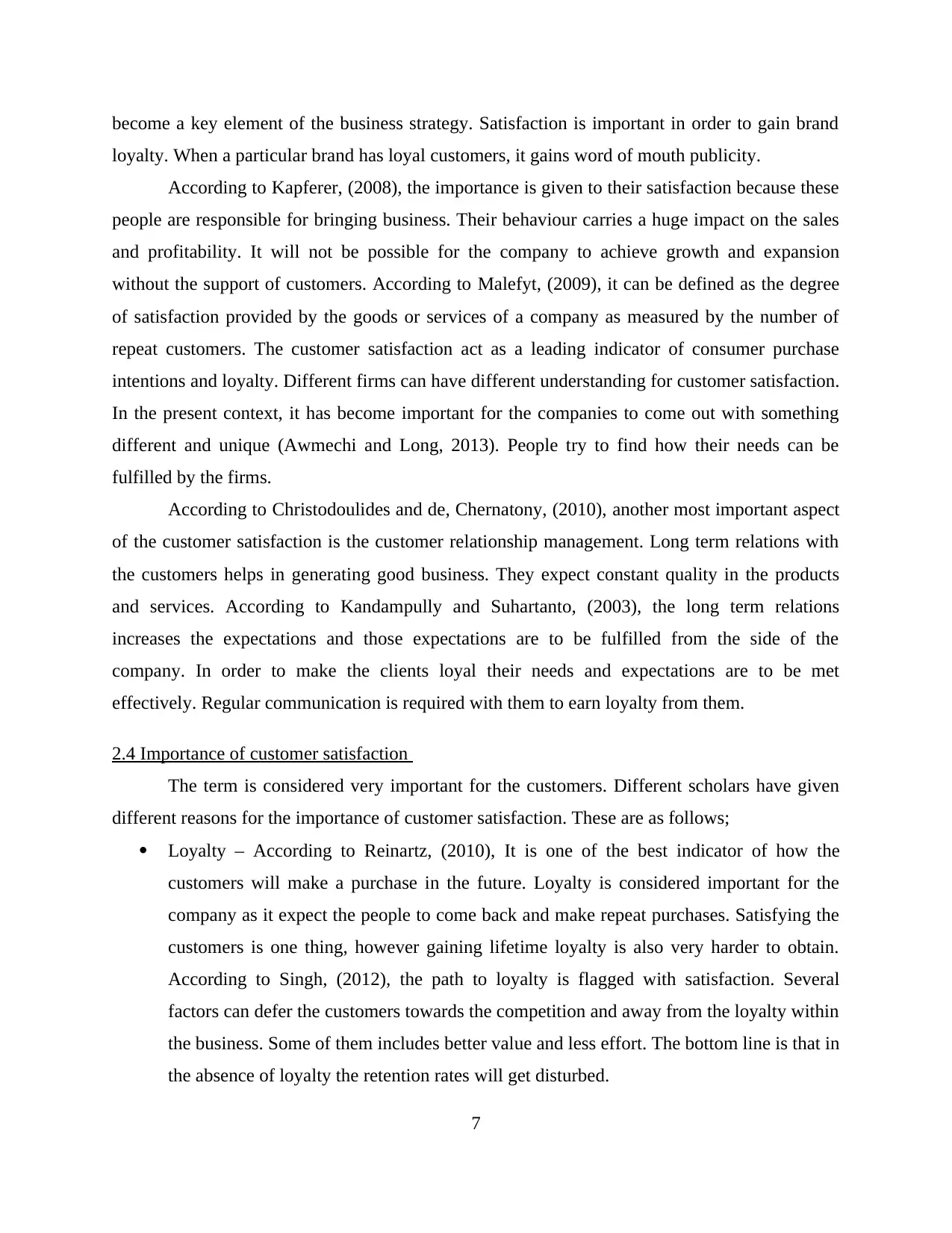
become a key element of the business strategy. Satisfaction is important in order to gain brand
loyalty. When a particular brand has loyal customers, it gains word of mouth publicity.
According to Kapferer, (2008), the importance is given to their satisfaction because these
people are responsible for bringing business. Their behaviour carries a huge impact on the sales
and profitability. It will not be possible for the company to achieve growth and expansion
without the support of customers. According to Malefyt, (2009), it can be defined as the degree
of satisfaction provided by the goods or services of a company as measured by the number of
repeat customers. The customer satisfaction act as a leading indicator of consumer purchase
intentions and loyalty. Different firms can have different understanding for customer satisfaction.
In the present context, it has become important for the companies to come out with something
different and unique (Awmechi and Long, 2013). People try to find how their needs can be
fulfilled by the firms.
According to Christodoulides and de, Chernatony, (2010), another most important aspect
of the customer satisfaction is the customer relationship management. Long term relations with
the customers helps in generating good business. They expect constant quality in the products
and services. According to Kandampully and Suhartanto, (2003), the long term relations
increases the expectations and those expectations are to be fulfilled from the side of the
company. In order to make the clients loyal their needs and expectations are to be met
effectively. Regular communication is required with them to earn loyalty from them.
2.4 Importance of customer satisfaction
The term is considered very important for the customers. Different scholars have given
different reasons for the importance of customer satisfaction. These are as follows;
Loyalty – According to Reinartz, (2010), It is one of the best indicator of how the
customers will make a purchase in the future. Loyalty is considered important for the
company as it expect the people to come back and make repeat purchases. Satisfying the
customers is one thing, however gaining lifetime loyalty is also very harder to obtain.
According to Singh, (2012), the path to loyalty is flagged with satisfaction. Several
factors can defer the customers towards the competition and away from the loyalty within
the business. Some of them includes better value and less effort. The bottom line is that in
the absence of loyalty the retention rates will get disturbed.
7
loyalty. When a particular brand has loyal customers, it gains word of mouth publicity.
According to Kapferer, (2008), the importance is given to their satisfaction because these
people are responsible for bringing business. Their behaviour carries a huge impact on the sales
and profitability. It will not be possible for the company to achieve growth and expansion
without the support of customers. According to Malefyt, (2009), it can be defined as the degree
of satisfaction provided by the goods or services of a company as measured by the number of
repeat customers. The customer satisfaction act as a leading indicator of consumer purchase
intentions and loyalty. Different firms can have different understanding for customer satisfaction.
In the present context, it has become important for the companies to come out with something
different and unique (Awmechi and Long, 2013). People try to find how their needs can be
fulfilled by the firms.
According to Christodoulides and de, Chernatony, (2010), another most important aspect
of the customer satisfaction is the customer relationship management. Long term relations with
the customers helps in generating good business. They expect constant quality in the products
and services. According to Kandampully and Suhartanto, (2003), the long term relations
increases the expectations and those expectations are to be fulfilled from the side of the
company. In order to make the clients loyal their needs and expectations are to be met
effectively. Regular communication is required with them to earn loyalty from them.
2.4 Importance of customer satisfaction
The term is considered very important for the customers. Different scholars have given
different reasons for the importance of customer satisfaction. These are as follows;
Loyalty – According to Reinartz, (2010), It is one of the best indicator of how the
customers will make a purchase in the future. Loyalty is considered important for the
company as it expect the people to come back and make repeat purchases. Satisfying the
customers is one thing, however gaining lifetime loyalty is also very harder to obtain.
According to Singh, (2012), the path to loyalty is flagged with satisfaction. Several
factors can defer the customers towards the competition and away from the loyalty within
the business. Some of them includes better value and less effort. The bottom line is that in
the absence of loyalty the retention rates will get disturbed.
7
Paraphrase This Document
Need a fresh take? Get an instant paraphrase of this document with our AI Paraphraser
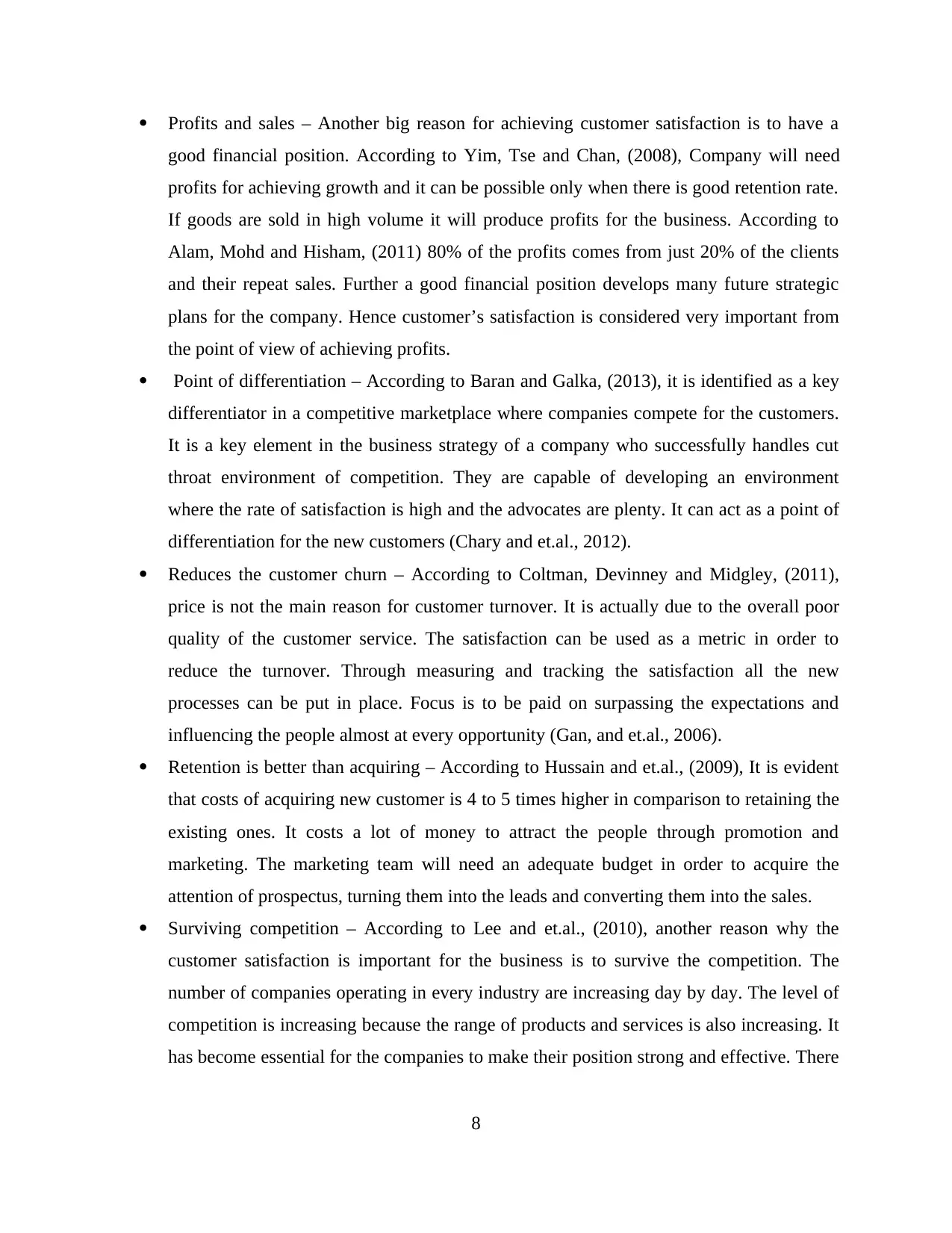
Profits and sales – Another big reason for achieving customer satisfaction is to have a
good financial position. According to Yim, Tse and Chan, (2008), Company will need
profits for achieving growth and it can be possible only when there is good retention rate.
If goods are sold in high volume it will produce profits for the business. According to
Alam, Mohd and Hisham, (2011) 80% of the profits comes from just 20% of the clients
and their repeat sales. Further a good financial position develops many future strategic
plans for the company. Hence customer’s satisfaction is considered very important from
the point of view of achieving profits.
Point of differentiation – According to Baran and Galka, (2013), it is identified as a key
differentiator in a competitive marketplace where companies compete for the customers.
It is a key element in the business strategy of a company who successfully handles cut
throat environment of competition. They are capable of developing an environment
where the rate of satisfaction is high and the advocates are plenty. It can act as a point of
differentiation for the new customers (Chary and et.al., 2012).
Reduces the customer churn – According to Coltman, Devinney and Midgley, (2011),
price is not the main reason for customer turnover. It is actually due to the overall poor
quality of the customer service. The satisfaction can be used as a metric in order to
reduce the turnover. Through measuring and tracking the satisfaction all the new
processes can be put in place. Focus is to be paid on surpassing the expectations and
influencing the people almost at every opportunity (Gan, and et.al., 2006).
Retention is better than acquiring – According to Hussain and et.al., (2009), It is evident
that costs of acquiring new customer is 4 to 5 times higher in comparison to retaining the
existing ones. It costs a lot of money to attract the people through promotion and
marketing. The marketing team will need an adequate budget in order to acquire the
attention of prospectus, turning them into the leads and converting them into the sales.
Surviving competition – According to Lee and et.al., (2010), another reason why the
customer satisfaction is important for the business is to survive the competition. The
number of companies operating in every industry are increasing day by day. The level of
competition is increasing because the range of products and services is also increasing. It
has become essential for the companies to make their position strong and effective. There
8
good financial position. According to Yim, Tse and Chan, (2008), Company will need
profits for achieving growth and it can be possible only when there is good retention rate.
If goods are sold in high volume it will produce profits for the business. According to
Alam, Mohd and Hisham, (2011) 80% of the profits comes from just 20% of the clients
and their repeat sales. Further a good financial position develops many future strategic
plans for the company. Hence customer’s satisfaction is considered very important from
the point of view of achieving profits.
Point of differentiation – According to Baran and Galka, (2013), it is identified as a key
differentiator in a competitive marketplace where companies compete for the customers.
It is a key element in the business strategy of a company who successfully handles cut
throat environment of competition. They are capable of developing an environment
where the rate of satisfaction is high and the advocates are plenty. It can act as a point of
differentiation for the new customers (Chary and et.al., 2012).
Reduces the customer churn – According to Coltman, Devinney and Midgley, (2011),
price is not the main reason for customer turnover. It is actually due to the overall poor
quality of the customer service. The satisfaction can be used as a metric in order to
reduce the turnover. Through measuring and tracking the satisfaction all the new
processes can be put in place. Focus is to be paid on surpassing the expectations and
influencing the people almost at every opportunity (Gan, and et.al., 2006).
Retention is better than acquiring – According to Hussain and et.al., (2009), It is evident
that costs of acquiring new customer is 4 to 5 times higher in comparison to retaining the
existing ones. It costs a lot of money to attract the people through promotion and
marketing. The marketing team will need an adequate budget in order to acquire the
attention of prospectus, turning them into the leads and converting them into the sales.
Surviving competition – According to Lee and et.al., (2010), another reason why the
customer satisfaction is important for the business is to survive the competition. The
number of companies operating in every industry are increasing day by day. The level of
competition is increasing because the range of products and services is also increasing. It
has become essential for the companies to make their position strong and effective. There
8
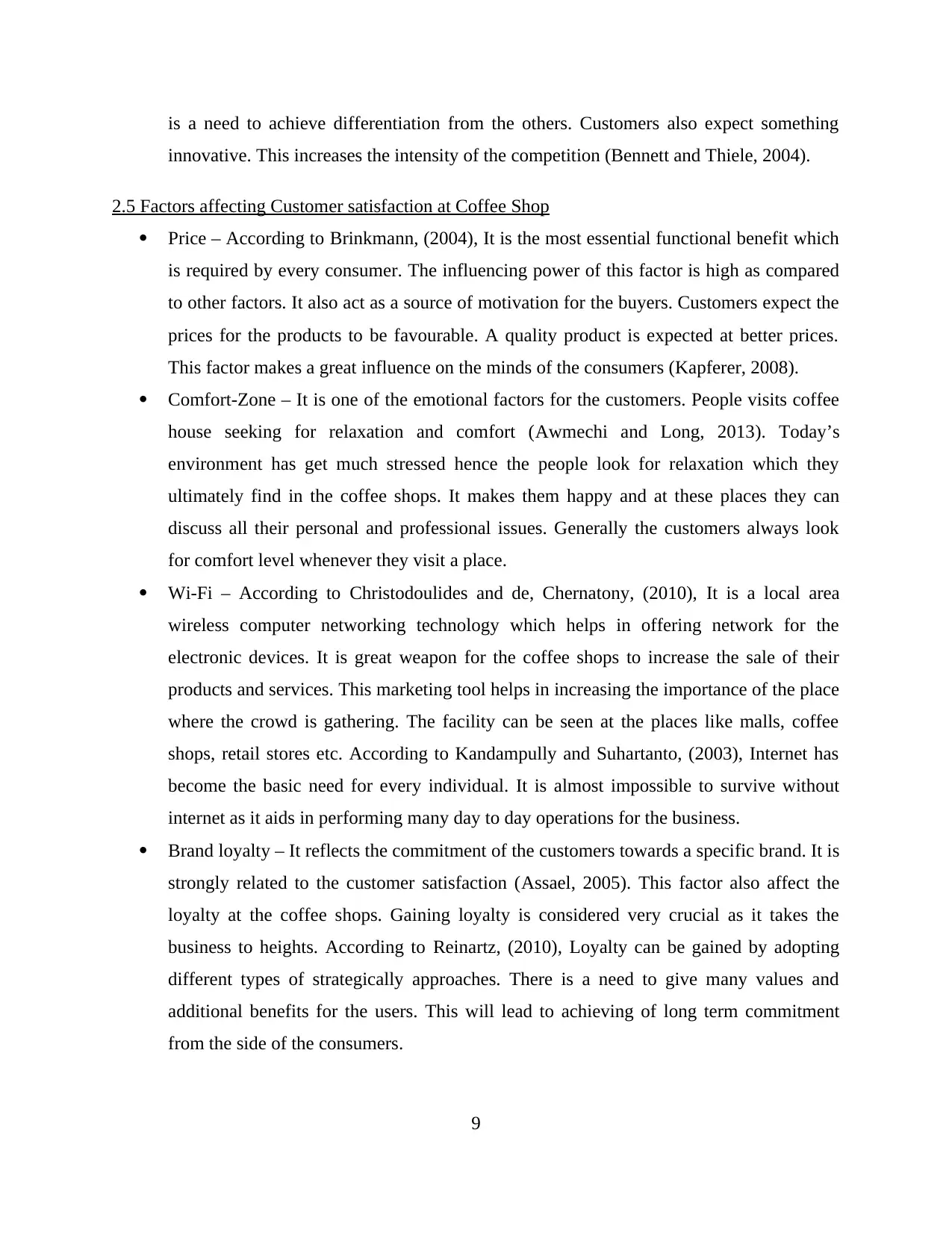
is a need to achieve differentiation from the others. Customers also expect something
innovative. This increases the intensity of the competition (Bennett and Thiele, 2004).
2.5 Factors affecting Customer satisfaction at Coffee Shop
Price – According to Brinkmann, (2004), It is the most essential functional benefit which
is required by every consumer. The influencing power of this factor is high as compared
to other factors. It also act as a source of motivation for the buyers. Customers expect the
prices for the products to be favourable. A quality product is expected at better prices.
This factor makes a great influence on the minds of the consumers (Kapferer, 2008).
Comfort-Zone – It is one of the emotional factors for the customers. People visits coffee
house seeking for relaxation and comfort (Awmechi and Long, 2013). Today’s
environment has get much stressed hence the people look for relaxation which they
ultimately find in the coffee shops. It makes them happy and at these places they can
discuss all their personal and professional issues. Generally the customers always look
for comfort level whenever they visit a place.
Wi-Fi – According to Christodoulides and de, Chernatony, (2010), It is a local area
wireless computer networking technology which helps in offering network for the
electronic devices. It is great weapon for the coffee shops to increase the sale of their
products and services. This marketing tool helps in increasing the importance of the place
where the crowd is gathering. The facility can be seen at the places like malls, coffee
shops, retail stores etc. According to Kandampully and Suhartanto, (2003), Internet has
become the basic need for every individual. It is almost impossible to survive without
internet as it aids in performing many day to day operations for the business.
Brand loyalty – It reflects the commitment of the customers towards a specific brand. It is
strongly related to the customer satisfaction (Assael, 2005). This factor also affect the
loyalty at the coffee shops. Gaining loyalty is considered very crucial as it takes the
business to heights. According to Reinartz, (2010), Loyalty can be gained by adopting
different types of strategically approaches. There is a need to give many values and
additional benefits for the users. This will lead to achieving of long term commitment
from the side of the consumers.
9
innovative. This increases the intensity of the competition (Bennett and Thiele, 2004).
2.5 Factors affecting Customer satisfaction at Coffee Shop
Price – According to Brinkmann, (2004), It is the most essential functional benefit which
is required by every consumer. The influencing power of this factor is high as compared
to other factors. It also act as a source of motivation for the buyers. Customers expect the
prices for the products to be favourable. A quality product is expected at better prices.
This factor makes a great influence on the minds of the consumers (Kapferer, 2008).
Comfort-Zone – It is one of the emotional factors for the customers. People visits coffee
house seeking for relaxation and comfort (Awmechi and Long, 2013). Today’s
environment has get much stressed hence the people look for relaxation which they
ultimately find in the coffee shops. It makes them happy and at these places they can
discuss all their personal and professional issues. Generally the customers always look
for comfort level whenever they visit a place.
Wi-Fi – According to Christodoulides and de, Chernatony, (2010), It is a local area
wireless computer networking technology which helps in offering network for the
electronic devices. It is great weapon for the coffee shops to increase the sale of their
products and services. This marketing tool helps in increasing the importance of the place
where the crowd is gathering. The facility can be seen at the places like malls, coffee
shops, retail stores etc. According to Kandampully and Suhartanto, (2003), Internet has
become the basic need for every individual. It is almost impossible to survive without
internet as it aids in performing many day to day operations for the business.
Brand loyalty – It reflects the commitment of the customers towards a specific brand. It is
strongly related to the customer satisfaction (Assael, 2005). This factor also affect the
loyalty at the coffee shops. Gaining loyalty is considered very crucial as it takes the
business to heights. According to Reinartz, (2010), Loyalty can be gained by adopting
different types of strategically approaches. There is a need to give many values and
additional benefits for the users. This will lead to achieving of long term commitment
from the side of the consumers.
9
⊘ This is a preview!⊘
Do you want full access?
Subscribe today to unlock all pages.

Trusted by 1+ million students worldwide
1 out of 47
Related Documents
Your All-in-One AI-Powered Toolkit for Academic Success.
+13062052269
info@desklib.com
Available 24*7 on WhatsApp / Email
![[object Object]](/_next/static/media/star-bottom.7253800d.svg)
Unlock your academic potential
Copyright © 2020–2025 A2Z Services. All Rights Reserved. Developed and managed by ZUCOL.





